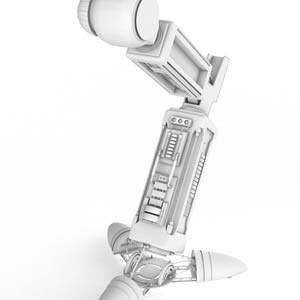
Redirecting nerves from the thigh muscle to control an experimental robotic leg makes it easier to use and more like a natural leg, researchers report.
The leg's movements are guided by the patient's original nerves, which have been redirected to a small area of the thigh muscle. The robotic leg senses the unconscious muscle movements and translates them into movements for the knee and ankle of the 4.5kg device.
Levi Hargrove of the Rehabilitation Institute of Chicago said: "This technology offers a seamless transition to walking around, climbing and descending stairs and moving around on slopes and even repositioning the prosthesis without thinking about it.
"That's something no other device offers."
Read: Man froze off 'hated' right leg
Responds quickly
Zac Vawter, 31, who lives in the Seattle area and lost his right knee following a motorcycle accident, has been testing the device and is the subject of a case report by Hargrove and colleagues in The New England Journal of Medicine.
Vawter said the bionic leg "is a big improvement compared to my regular prosthetic leg because it responds quickly and more appropriately, allowing me to interact with my environment in a way that is similar to how I moved before my amputation."
"The device is one of many ongoing attempts to develop powered artificial limbs that reproduce the complex process of walking – both to help restore motion to amputees or for people with other problems such as spinal cord injuries. But all have their limitations."
Read: Scientists create biochemical legs
The robotic leg is being developed with an $8m (R80m) grant from the US Army.
There are more than one million lower leg amputees in the US.
Troy Turner, a member of the scientific advisory panel of The Amputee Coalition in Manassas, Virginia, said the project represents the first true effort at letting someone control their prosthetic leg in a way that's very similar to biologic control.
Turner, who is a rehabilitation and human performance portfolio manager with the US Army’s medical research centre in Fort Detrick, Maryland, estimated that only about four to six groups were researching the problem on this high level.
Available for commercial market
"I think this will be the first real successful effort in making it available for the commercial market.
"It also lays the groundwork for a lot of continued efforts in taking this concept much further," he said.
A similar system has been used in robotic arms for years, but the challenge is greater in developing a robotic leg, according to Hargrove, because users of a robotic arm don't face a serious risk of falling if the signals are misread.
"If you're using a bionic arm and it misbehaves, the elbow may move slightly, but if the prosthetic leg misbehaves... that could be quite a safety issue," Hargrove said.
Read: Patella-Femoral syndrome
In addition, "it has to be able to hold the person's weight, generate huge amounts of torque and power to help push a person along or lift them up the stairs. So strictly from a mechanical engineering standpoint, it's very, very difficult to actually design a robotic leg," he said.
The leg does have limitations, the researcher said.
"We need to make it lighter, quieter, have the battery life that lasts a bit longer" and reduce the movement error rate. The current model is good for about 5 000 steps. The Army's goal is 10 000 steps.
The work was done in conjunction with Vanderbilt University in Nashville and researchers from Northwestern University in Evanston, Illinois, and the University of Seattle.
Read more:




 Publications
Publications
 Partners
Partners















